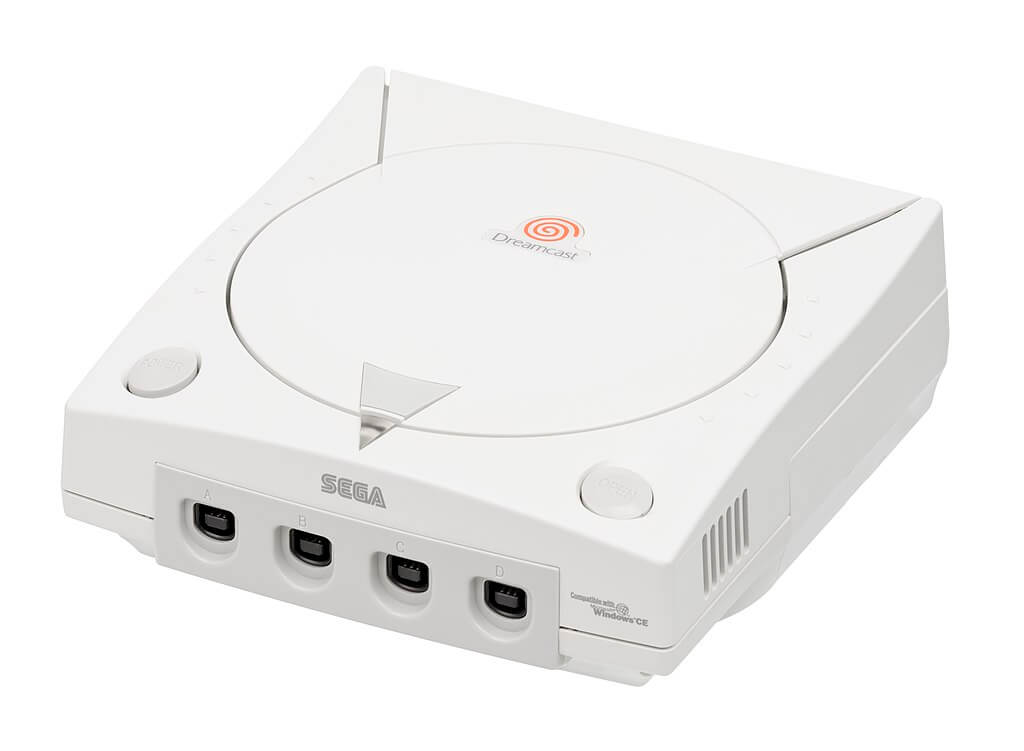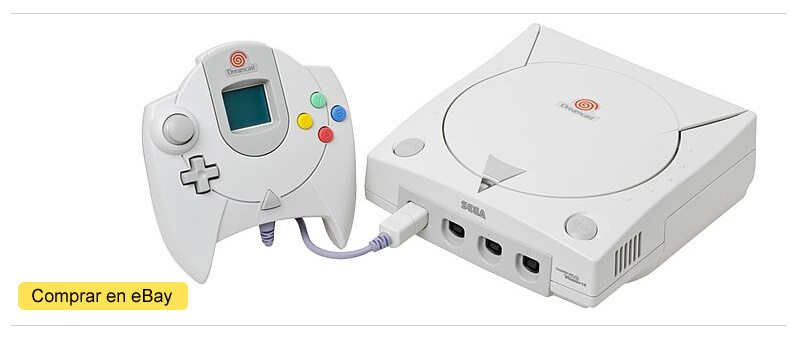Dreamcast is the last console of the legendary SEGA, it was launched on November 27, 1998 in Japan at a price of 29,000 yen and discontinued in March 2001, selling a total of 10.6 million consoles worldwide.
Dreamcast was the first sixth-generation video game console, a machine far superior to anything seen before, but which we simple players did not know or want to appreciate. Many years later, aware of our mistake, the Dreamcast has repositioned itself as one of the best consoles in history… Let’s see why.
| COMPANY: | SEGA |
| CONSOLE GENERATION: | SIXTH GENERATION |
| RELEASE DATE: | November 27, 1998 in Japan September 9, 1999 in North America October 14, 1999 in Europe |
| GAMES CATALOG: | 624 games |
| SOLD UNITS: | 10.6 million worldwide |
| LAUNCH PRICE: | 29,000 yen US$199 39.900 Ptas. |
| PROCESSOR: | 200 MHz Hitachi SH – 4 RISC |
| FORMAT: | GD-ROM |
- History of the Dreamcast
- VMU: Visual Memory Unit
- Shenmue from SEGA-AM2
- Price of a Dreamcast console, how much did it cost?
- Collect the Dreamcast
- Buying a Dreamcast on eBay
- TOP Retro: Best Dreamcast Games
- FAQ Sega Dreamcast
Dreamcast, the 128-bit console from SEGA
Dreamcast is one of the best consoles that have ever existed in relation to its time, a machine ahead of its time that knew how to make the generational leap with respect to its competition, learning from its past mistakes and offering endless new possibilities and improvements.
Classified and promoted as a 128-bit console, SEGA bet everything in 1998 with its new console, trying to leave behind the commercial error of the Saturn and enter a market dominated worldwide by Sony and its PSX, followed at a distance by the powerful Nintendo 64 and its ill-advised cartridges.
As we like to do at Infoconsolas, to fully understand what the Dreamcast was like and what it meant, let’s first learn about its context, situation and what people expected from a company like Sega in the years after its launch.
Background to the Sega Dreamcast
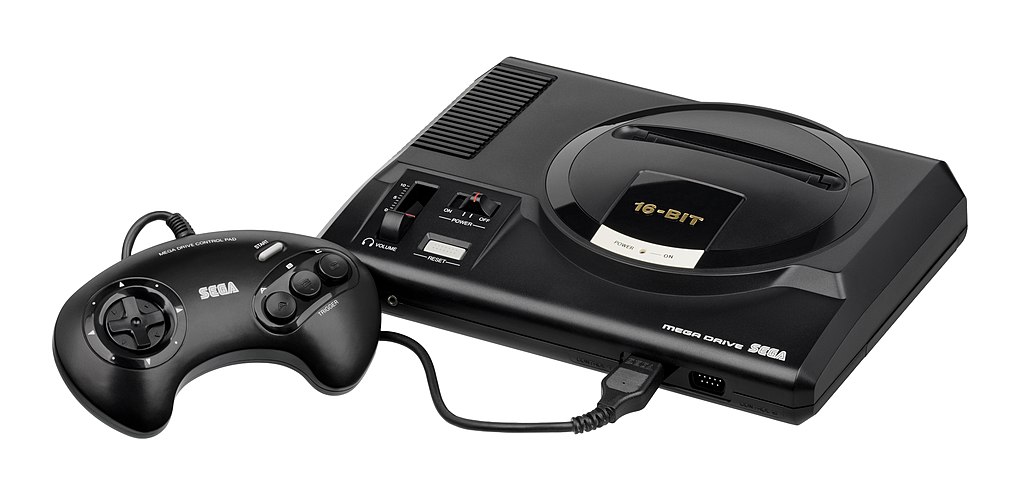
Although SEGA’s beginnings in the world of 8-bit home consoles with its SG-1000 were marked by Nintendo and its Famicom, its good work and experience in the world of recreational machines led years later to bring to the homes of everyone a machine capable of porting the hits of their SEGA System 16 arcade board, we are referring to the 16-bit Mega Drive, released in 1988 in Japan.
We are talking about the golden years of the blue hedgehog company, when it triumphed in arcades and in homes with 3 simultaneous consoles on the market: Master System, Game Gear and Mega Drive, with the MegaDrive (Sega Genesis) being the console that most joys caused him, with its more than 30 million units sold worldwide. SEGA and Nintendo shared the video game cake at the time.
At this point, it would be normal to comment that in 1994 SEGA launched its next console, the 32-bit Saturn, but unfortunately it was not exactly like that:
The not very successful Mega CD released in Japan in 1991 and later in the rest of the world, was joined by countless consoles and versions of the MegaDrive/Genesis with and without the Mega CD. Far from having a single system to promote, SEGA began licensing their products to other brands and releasing different MegaDrive models themselves.
This could have been left there, but on November 22, 1994, SEGA launched the 32X in North America, exactly the same day that the Saturn saw the light in Japan… BIG MISTAKE: The 32X was a peripheral that transformed our MegaDrive on a 32-bit console… Just when SEGA had just released their new 32-bit. As if this were not enough, SEGA let the media speculate and publish without denial, that the MEGADRIVE + MEGA CD + 32X = SEGA SATURN… When in no case was it like that, really the combo was much inferior to the Saturn and in no way case was compatible.
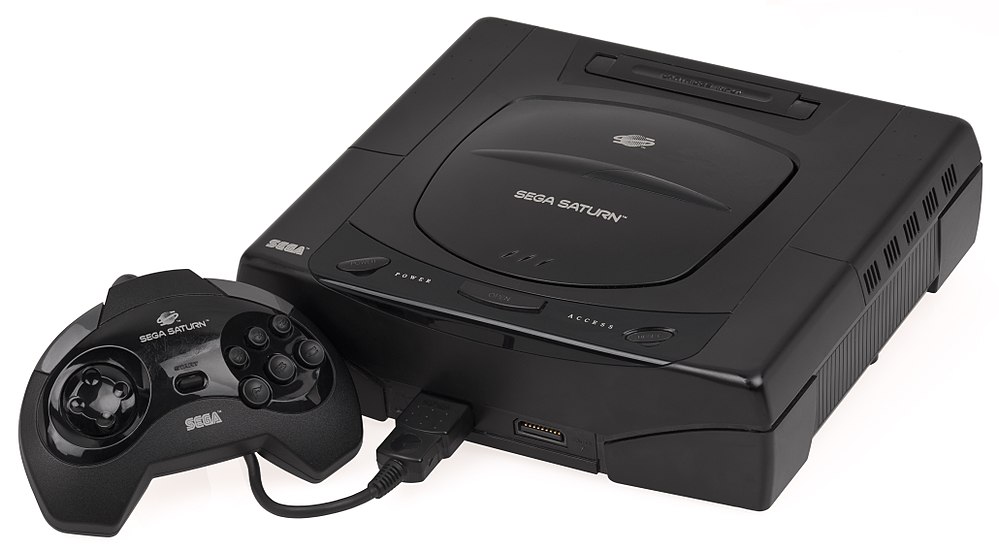
The result was a gigantic loss of reputation and credibility on the part of SEGA, the users interpreted that SEGA had deceived them, suffering those who had bought the 32X the cessation of production of the peripheral in 1996, with all that this means. In this way, SEGA began the 32-bit Battle with an image crisis and conflicts between its two delegations, the American and the Japanese.
The SEGA Saturn was the one who suffered from the distrust of users with the brand and also had the misfortune of facing one of the most powerful consoles in all of history in relation to its time, the PlayStation, a brown beast that was very superior regarding the catalog and quality of its games, due in large part to the fact that Saturn turned out to be a very difficult console to program compared to the PS1: SEGA had opted for a complex architecture based on 2 main processors, which had to work together , so very few games took advantage of its real capacity.
Saturn's dual CPU Although today it is very common and theoretically positive to talk about graphics and CPUs working in parallel, the case of Saturn was different: When SEGA learned that the PSX CPU had a clock frequency of 33.86 MHz, higher than the Sega Saturn's 32-bit Hitachi SH-2 at 28.6 MHz, SEGA decided to incorporate another Hitachi SH-2 at 28.6 MHz with a master-slave protocol, which made it difficult to synchronize. This fact, which was supposed to mean the superiority of the Saturn over the PS1, ended up being a problem for the programmers, who did not have enough expertise to program 2 CPUs.
But there is even more with the Saturn, in a world that was clearly oriented towards 3D and polygonal graphics, on the Saturn 3D graphics were displayed in 4-vertex polygons, instead of the 3-vertex that ended up being the standard due to its greatest versatility. This fact involved extra work in modeling three-dimensional graphics when programming conversions, which had to be created from scratch, assuming long waits for launches or directly not publishing many games on their system.
Released in November 1994 in Japan and 1995 in North America and Europe, the Sega Saturn was discontinued in North America and Europe in 1998, just 3 years after its release. To the previous perceptions on the part of the players of cheating by the 32X and of failure by its multiple consoles and MegaDrive/Mega CD variants (as none of them succeeded), in addition to the loss to the SNES in the 16-bit battle , now added a new perception: ABANDONMENT, Sega abandoned users who bought their systems (32x / Saturn) after a few years.
Note that I speak of “perceptions”, not facts. I am not going to assess events, reasons or justifications, but the users’ perception was of abandonment, at a time when there was no possibility of transmitting any direct message from companies to their users via networks or email. The faithful user of Sega felt alone and disappointed… And so, with this scenario and this total loss of general confidence, the Dreamcast came to the world in 1998.
Dreamcast, the best console of its time
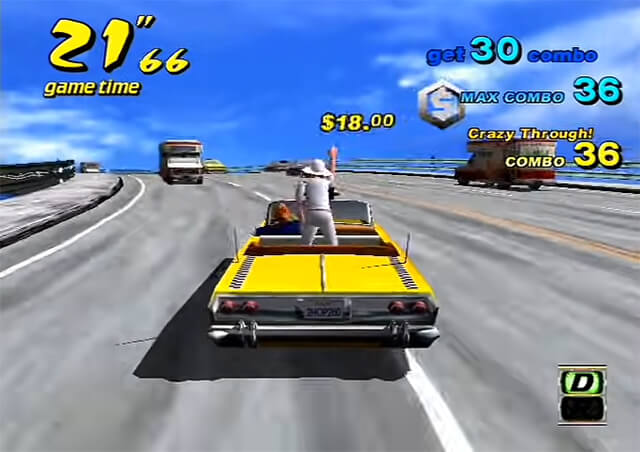
As we have said, Sega only sold 10.6 million consoles worldwide, but why at Infoconsolas do we say that the Dreamcast is one of the best consoles in relation to its time if it was an absolute commercial failure? Let’s take a look at its benefits:
At the performance level, the Dreamcast clearly surpassed its previous generation competitors in 1998, being able to show under a definition of 640 x 480, 3,000,000 polygons per second on the screen, compared to 500,000 for the N64 and 360,000 for the PSX (Theoretically, without programming logic or physics, the Dreamcast can display 7 million polygons.) The result was as expected, their games were far superior to the competition, the generation gap was visible and tangible.
Learning from what happened with the Sega Saturn and the difficulty of programming for its 32-bit console, SEGA allied itself with Microsoft itself to create a version of its Windows CE operating system with its corresponding libraries and Direct X, thus facilitating PC to Dreamcast conversions (at the time our PCs were Pentium II and Pentium III). Although Windows CE is generally a great advantage, due to an overload of memory usage, most programmers opted to use the internal operating system prepared by SEGA and its 3D graphics library, the “Ninja Library”. How not to love SEGA with these nicknames?
The Dreamcast was the first console in the history of video games to feature a built-in modem, literally opening up a new world that until then had been restricted to PCs. From the previous generation it had learned what the format of the future was, so SEGA opted for GD-ROM, its own optical format developed together with Yamaha, based on CD-ROM technology which had 1 GB of capacity, being much cheaper to produce than a cartridge.
Unlike previous generations, its GD-ROM reader had a speed of 12x, which added to its 16 MB of RAM, 8 MB of RAM for graphics and 2MB of RAM for sound, made the loads and fluidity of the games was far superior to what was seen on other consoles, making sure not to repeat glitches like the Neo Geo CD and its endless frustrating loads.
Unlike previous generations, its GD-ROM reader had a speed of 12x, which added to its 16 MB of RAM, 8 MB of RAM for graphics and 2MB of RAM for sound, made the loads and fluidity of the games was far superior to what was seen on other consoles, making sure not to repeat glitches like the Neo Geo CD and its endless frustrating loads.
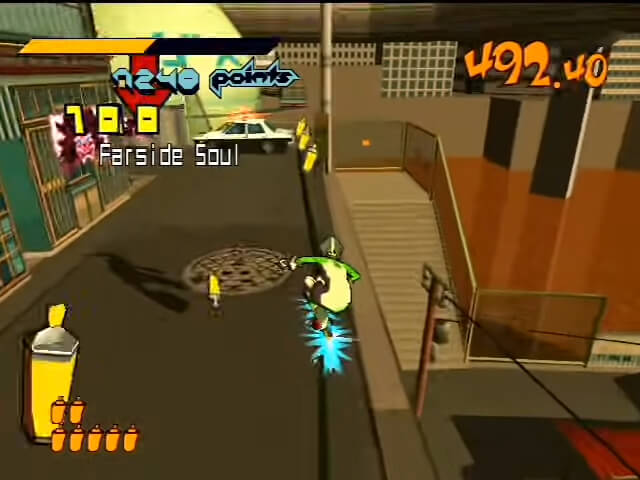
And how could it be otherwise, its games: With a catalog of 624 games released worldwide (499 in Japan), the Dreamcast had a very prolific short life, launching for example in Japan 113 games in 1999, 161 in in 2000 and 118 in 2001, some brutal figures for a console that stopped being manufactured after 3 years and sold only 10 million units. For example, the Wii U had 5 years of production, sold 13 million units and only had 110 games in its catalog.
The large number of Dreamcast games is a sign of the enormous expectations that it had created in the developers themselves, after all, we are talking about a console that had its older sister in arcades, the SEGA NAOMI arcade board. , the same system with more video, audio and RAM memory, which loaded the games in ROM format. Consequently, conversions from SEGA NAOMI to Dreamcast were practically identical, as well as very easy to port for developers.
In this way, thanks to its compatibility with Pentium technology (Windows CE) and with the SEGA NAOMI arcade, Dreamcast opted for a large number of high-quality video games, highlighting the arcade game developers that brought their successes to the system. As with NEO GEO, we could say that we had an arcade machine at home, but this time for a ridiculously low price for the time.
Retro curiosity! Three projects were left without seeing the light as peripherals for the control of the Dreamcast: 1. A laser pointer to point at the television directly from our remote as a mouse and gun. 2. A motion and G-force sensor similar to the one later integrated into the PS3's SIXAXIS controller. 3. A peripheral for wireless communication with the console, which should also include a battery.
To the delight of Dreamcast owners, SEGA’s 128-bit console was not limited to arcade or PC conversions, its great features brought us new-generation games designed for the console market, which still survive today. collective imagination: Rez, Phantasy Star Online, Sonic Adventure or Shenmue, are some of the games that marked the way forward for the industry and that we should all play at some point in our lives.
And that was the SEGA Dreamcast console, a great 128-bit machine, the first console of its generation (the first of its name ;), one ahead of its time that, once given the opportunity, more than fulfilled the expectations that any player could have in 1998 with a system that cost $199. Let’s be clear, Dreamcast was a real wonder at a ridiculous price with a luxury catalog. Triumph? Not at all as we have already seen…
Life, decline and death of the Dreamcast, the last SEGA console
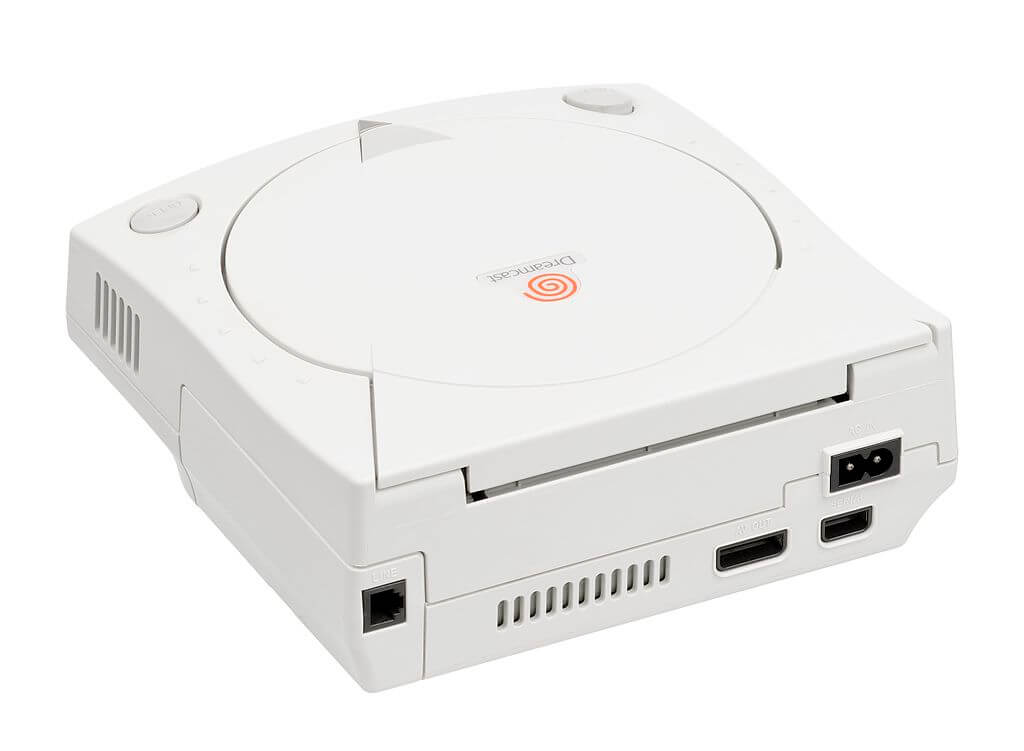
Known as the Katana project since the beginning of 1998, it was released on November 27, 1998 in Japan, Dreamcast had been born exhausting all stocks on the first day and selling approx. 500,000 units in its first two weeks. What should be a positive fact, in this case it was the opposite:
Prior to its release, the development of the 128-bit graphics chip for the Dreamcast, developed by NEC and the British company VideoLogic, the PowerVR2, had been considerably delayed, causing this fact a considerable negative impact on the production of the console and a consequent lower number of units. Even though SEGA delayed the launch for a week (it was initially planned for the 20th), this period of time was not enough, as it was released with a very small number of consoles.
Sega estimated that at its launch it could have sold between 200,000 and 300,000 more consoles if it had had stock available, quite a blow, but its problems did not end there: Much worse than the previous point, the delay in the graphics chip was also a major setback for developers, so on the day of its launch the Dreamcast only had 4 video games:
- Godzilla Generations
- July
- Pen Pen Tri-icelon
- Virtua Fighter 3tb
In case anyone has any doubts, only the port of the great Virtua Fighter 3tb was a sales success, with the other 3 video games being mere accompaniments, especially when SEGA had announced that along with the launch of its 128-bit console, Sonic Adventure and the Sega Rally Championship 2, something that did not happen and for which the Japanese had to wait weeks.
Such was the launch logistics blunder, that just 15 days after launch, Eiichi Yukawa senior executive director was demoted. If Dreamcast was the console designed for the resurgence of the company and make up for past mistakes, the life of the console could not have started worse.
And it is that as we have explained in the previous section related to the background, SEGA started in this generation with a totally reviled brand image as well as disappointed and distrustful users with the company. Given this circumstance, SEGA could not afford a start like the one it had… But it was.
Although as of 1999 the releases of the Sega console were of great quality and very numerous, to their misfortune their direct competitors of 32 and 64 bits had in that same year releases of authentic great games, which sent the unequivocal message to their users who still had a long life ahead of them, the new generation could wait.
To give some examples, let’s see some of the launches of the PS1 and N64 in 1999, the year that should be the takeoff and consolidation of the Dreamcast:
- PS1 – Final Fantasy VIII
- PS1 – Bust a Groove 2
- PS1 – Grand Theft Auto
- PS1 – Ace Combat 3: Electrosphere
- PS1 – ISS Pro Evolution
- PS1 – Formula One 99
- PS1 – Chrono Trigger
- PS1 – Alundra 2: A New Legend Begins
- PS1 – Chrono Cross
- PS1 – Dance Dance Revolution 2ndReMix Append Club Version Vol.1
- PS1 – Gran Turismo 2
- PS1 – Ape Escape
- N64 – Super Smash Bros.
- N64 – Harvest Moon 64
- N64 – Castlevania
- N64 – Pokémon Stadium
- N64 – Mario Golf
- N64 – Turok 2: Seeds of Evil
- N64 – Star Wars Episode I: Racer
- N64 – International Superstar Soccer 2000
- N64 – Star Wars: Rogue Squadron
- N64 – Donkey Kong 64
- N64 – Mario Party 2
- N64 – Resident Evil 2
Make no mistake, the Dreamcast had in 1999 an endless number of good games technically far superior to those of the previous generation, but not enough… If the SEGA of 1998 and 1999 had had the same image and reputation as that of In the early 90’s, the Dreamcast and its games would have been enough to catapult it to stardom, but Sega’s situation in 1999 was very different, the public mistrusted the company and feared they would be left with a failed and discontinued console in 1 or 2 years .
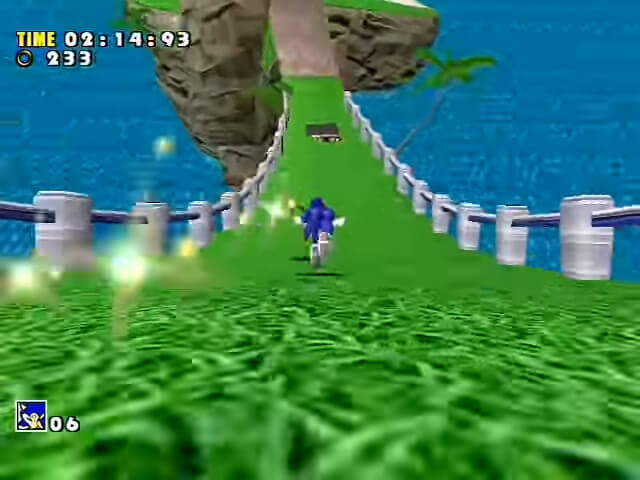
Anything else against the best Sega console since the days of MegaDrive? Yes, the hype of Sony and its PlayStation 2: Since 1997 numerous media outlets have been leaking rumors and features of what Sony’s second console would be like, but it was not until March 2, 1999 that Sony officially announced its next console and its characteristics (DVD, blue chip…), showing in September of the same year the technical demos of Gran Turismo 2000 and Tekken Tag Tournament.
To counteract the hype of Sony’s announcement, on June 1, 1999 SEGA announced a reduction from 29,800 yen to 19,900 yen for its console, making the serious mistake of not reducing its cost in production, so from the end of June 1999 SEGA lost 10,000 yen with each console sold.
The Dreamcast was dead and despite its good launch and role in the United States (but not in Europe and the rest of the world), most players quietly waited with their previous generation consoles for the Sony launch and their PS2, along with to the rest of the new generation consoles such as the Game Cube and Xbox.
When Sony launched its Ps2 in March 2000 in Japan, sales of its console, accessories, and video games were $250 million, far exceeding the $97 million made by the Dreamcast on its first day. The people had spoken, the Dreamcast was dead despite Sega America's attempts to hang on. On January 31, 2001, Sega officially announced that it was leaving the home console market, ceasing production of the Dreamcast and focusing from that moment on developing software for competition... PAIN, A LOT OF PAIN for all gamers around the globe .
From then on, SEGA was limited to selling all its stock with a heavily discounted console, reaching 9,900 yen in Japan. The Japanese consoles served to alleviate foreign demand by adapting them abroad and from 2004, once the stock of the assembled units had run out, reconditioned consoles coming from technical service parts were sold.
In 2007 SEGA finished the sale of its Dreamcast stock and consequently ended its activity as a manufacturer of home consoles. In March of the same year, the last official game for DC, Karous, is published. The Dreamcast was officially dead.
A sad life, a great system to discover
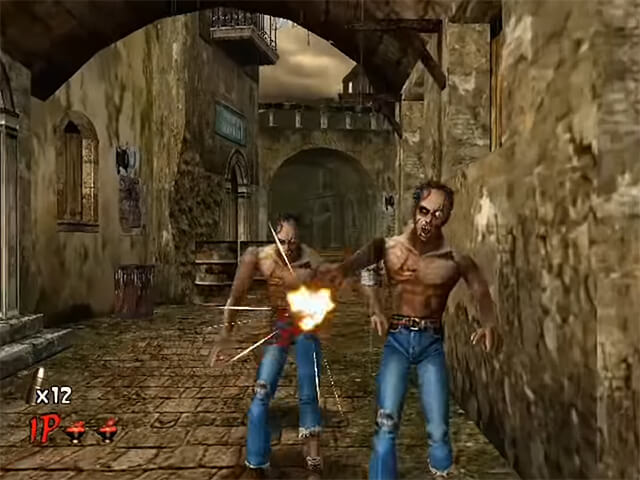
As you have seen, the Dreamcast had a life marked by past errors, present failures and future consoles. It is a pity that, where we normally dedicate ourselves to telling the benefits of a console and its games, in the case of the Dreamcast the most notable and important thing is, at an informative and communicative level, to explain how a console was dying little by little which nobody gave the real opportunity to compete with the rest of the consoles of its generation.
Time has shown us that the Sega console has a large catalog of games, but this large number of games was released for the ease of porting and converting to DC, rather than the number of units available and corresponding niche and potential. market. Despite its great catalog, the DC was a living corpse waiting for someone to deal the last blow… And Sony gladly gave it to them.
Fortunately, time and retro lovers have rediscovered this system, giving it a second chance and proclaiming to the four winds that the SEGA Dreamcast was a great console that we denied the opportunity to surprise us. And that’s right, if you have the opportunity to get hold of a Dreamcast, you will see with your own eyes a wide catalog of marked arcade style that offer a great and addictive alternative to the more domestic games that the rest of the 128-bit consoles offered us.
RETRO CURIOSITY! According to media such as Kotaku, Isao Okawa, President of Sega in the Dreamcast years, visited Microsoft headquarters and had contacts with Bill Gates to convince him that his new Xbox console was compatible with his Dreamcast, which was practically sentenced. In this way, in addition to increasing the market for SEGA as a developer, they would lengthen the life of the Dreamcast since new releases compatible with both consoles were guaranteed, while Xbox ensured a luxury catalog from day one. This win-win was cut short when SEGA demanded that its video games could also benefit from online gaming on the future Xbox (Xbox Live), to which Microsoft refused, granting that benefit to Xbox exclusives (already programmed for that purpose). ). The result? A frustrated fantasy for all SEGA fans.
Dreamcast did not manage to face the rest of the consoles of its generation. Could it have endured the type and market share with its technical benefits? The answer is simple, yes. Thanks to its exclusivities of the SEGA universe, its arcade ports of the SEGA Naomi and the conversions of the PC world, the Dreamcast could have endured as an economic console and its own and differentiated catalog… And it tried, but it did not succeed, we did not want, it was much what he had against.
Can the Dreamcast be compared to the rest of its generation? Of course it can be compared, the question is whether it should be. Dreamcast came out 2 and 3 years before its competitors, in a few years when technology was advancing by leaps and bounds. Consequently, despite the fact that the DC can do a very good job against its contemporaries of the generation, the reality is that it is technically inferior, so it does not make much sense to enter into debates about CPUs and megahertz. Only the mastery when it comes to programming for it made it possible for there to be games that are among the best games at a generational level.
As we have said, for all retro fans and/or lovers, the important thing today is that you give it the opportunity it deserves, from Infoconsolas we assure you that it is a console that will not disappoint you.
VMU: Visual Memory Unit

| COMPANY: | SEGA |
| CONSOLE GENERATION: | SIXTH GENERATION |
| RELEASE DATE: | November 27, 1998 in Japan September 9, 1999 in North America October 14, 1999 in Europe |
| GAMES CATALOG: | Minigames |
| SOLD UNITS: | 1 million approx. |
| LAUNCH PRICE: | 2.500 yen |
| PROCESSOR: | 200 MHz Hitachi SH – 4 RISC |
| FORMAT: | Internal memory |
Sega literally showed off with this peripheral, a memory card with a screen and controls included, which served both as a screen for our controllers offering extra video game information, and as a mini portable console with a catalog of games based on mini-games that were downloaded from the Dreamcast and its corresponding games.
As if this were not enough, the VMU could be interconnected with other VMUs to exchange saved games, data or play doubles. Quite an advance that marked a path which unfortunately and due to the arrival of hard drives, only Sony followed with its PocketStation for the PSX.
With a memory of 128 KB, it offered 200 blocks of storage, an amount that over time proved scarce. The definition of the LCD screen was 48 pixels high x 32 pixels wide, greatly limiting the playable possibilities of the machine, on a screen of 37 mm x 26 mm. To its different functions already mentioned, we must add the calendar… Quite a detail. Its measurements were 47 mm × 80 mm × 16 mm and it weighed 45 grams, using 2 CR2032 button batteries for its operation.
Although most video games were limited to putting their logo when the VMU acted as a second screen embedded in the controller, there were about 40 GD-ROMs that did include various uses, including applications or games in console mode and functions extras as a second screen, highlighting the minigames that complemented the main game, that is, with which you could get rewards, experience, levels, train your character… Giving the peripheral a great meaning.
The VMU did not revolutionize the world of video games, but it was an extremely interesting bet as well as an essential peripheral to enjoy 100% of the Dreamcast experience. Today, they are tremendously sought after by collectors, and there is a scene that offers us new homebrew content. Lucky for us, prices are still pretty cheap on the used market. Will the VMU be our perfect pocket retro console?
Shenmue from Sega-AM2
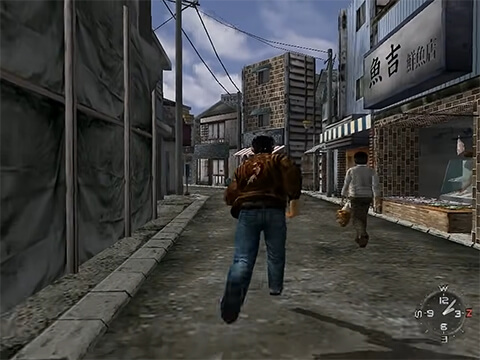
Shemue is a masterpiece of video games, one of the few games that we should all play in our lives, a benchmark within the industry that served to lay the foundations for video games of the following generations, both in narrative and rhythm as well as in mechanics. and fusion of genres. If Nintendo 64 and its Super Mario 64 defined 3D platforming, now it was SEGA’s turn.
Shenmue is a story of revenge from the realistic perspective of a son, who will gradually advance until he reaches his goal. Conversation after conversation, street after street, event after event, it gave us a completely unique gaming experience up to that point. An adventure, a social and life simulator, an open world, an ode to nostalgia and the future of video games that this time, SEGA imposed.
Initially conceived for the Sega Saturn as a Virtua Fighters RPG, the project led to the power, technical possibilities and the new market of the Dreamcast: More than 1,200 locations, 300 characters with their own lives, routines and personalities, an open world full of of mini-games and secondary missions, weather cycles of day and night through algorithms based on records from 1986, video scenes rendered in real time... All this caused Shenmue to become the most expensive video game in history up to that moment , about 50 million dollars approx.
Shenmue was a masterpiece, but it was also a game premature for its time and narratives for the time (December 1999), as well as a game that, in hindsight, was released on the wrong console at the wrong time:
Shenmue’s mature, calm and slow pace was not the trend in December 1999, being the first to offer such a deep gaming experience took its toll on all those players who simply wanted more action. It took years for the arrival of consoles like the Xbox 360 and PS3 to consolidate videogames comparable to what Shenmue offered as a gaming experience. The bulk of players were not ready for Shenmue in 1999.
And yet, it was late for the Dreamcast… If it had been one of the launch games, the combo of the first 128-bit console and Shemue would have had an overwhelming impact. On the contrary, at the time Shenmue was released, the general public perception of the Dreamcast was already that of a failed console, so Shenmue was not enough to counter that image.
Was Shenmue Released on the Wrong Console? It’s hard to say, but from a marketing point of view… Initially yes. He had no alternative, we know, but the base of Sega consoles on the market were not enough to handle and elevate a game of such caliber properly, so the bulk of players could only see it in specialized magazines, be amazed and to dream that the future games of the 128-bit generation would be like Shenmue to enjoy them one day, when we bought a next gen from another brand.
Shenmue sold 1.2 million units on a console that placed 10.6 million units worldwide, brutal figures for its own market share, but ridiculous in the video game market if we compare it with other masterpieces and benchmarks of the genre. Shenmue would never conquer the gaming world if it was limited to the Dreamcast. For example, Super Mario 64 sold 12 million units.
And still, after all that has been exposed, more than two decades later, here we are talking about the Shemue… Why? Very easy, because it is a work of art, a technical marvel, a sample of what the Dreamcast could offer us, a dream come true for all Sega lovers, an essential, historical game. Shenmue is THE GAME. That is why we dedicate a special space to it in this Infoconsole review of the Dreamcast, because without Shenmue, the Dreamcast loses a lot of integers, but with it, the Dreamcast makes all the sense in the world… It’s a shame we didn’t realize it in its moment…
The price of the Dreamcast
At Infoconsolas we always like to expose the price of the consoles based on their historical context and their competition, only in this way can we get an idea of how expensive or cheap they could be at the time of their launch. On this occasion, to know the price of the SEGA Dreamcast we will use two tables, one with the American prices (keeping the world/Japanese release date) and another with the Japanese prices. Let’s start with the prices in US dollars.
| CONSOLE | LAUNCH | PRICE | BRAND |
| 3DO | 1993 | US$699.99 | Panasonic (+ Sanyo y Golstar) |
| Jaguar | 1993 | US$ 249.99 | Atari |
| Saturn | 1994 | US$399 | Sega |
| PlayStation | 1994 | US$299 | Sony |
| Virtual Boy | 1995 | US$179.95 | Nintendo |
| Nintendo 64 | 1996 | US$199.99 | Nintendo |
| Dreamcast | 1998 | US$199 | Sega |
| PlayStation 2 | 2000 | US$299 | Sony |
| Game Cube | 2001 | US$199 | Nintendo |
| Xbox | 2001 | US$299 | Microsoft |
And now let’s see the price of the Dreamcast in yen, compared to the rest of the consoles released in Japan.
| CONSOLE | LAUNCH | PRICE | BRAND |
| Playdia | 1994 | 24.800 yenes | Bandai |
| Neo Geo CD | 1994 | 49,800 yenes | SNK |
| Saturn | 1994 | 44.800 yenes | Saturn |
| PlayStation | 1994 | 39.800 yenes | Sony |
| PC FX | 1994 | 49.800 yenes | NEC |
| Virtual Boy | 1995 | 15.000 yenes | Nintendo |
| Nintendo 64 | 1996 | 25.000 yenes | Nintendo |
| Dreamcast | 1998 | 29.000 yenes | SEGA |
| PlayStation 2 | 2000 | 39.800 yenes | Sony |
| Game Cube | 2001 | 25.000 yenes | Nintendo |
| Xbox | 2001 | 34.800 yenes | Microsoft |
Being the first sixth generation console, the Dreamcast was initially compared in price with the consoles present on the market, that is, a buoyant PSX, a dying Saturn and a Nintendo 64 that had not quite taken off. As you can see, the price of the DC was extremely attractive, more so being a next-gen console.
During its short period of life, as we have mentioned, it went down in price until it reached the recommended price of 9,900 yen. It didn’t even work with that, a real shame…
Collect the Dreamcast

In this section we always ask ourselves the same question: Is it worth collecting the Dreamcast? Yes, yes, yes, yes… And yes. We have already given a thousand reasons, there is no need to repeat them, but simply to be able to enjoy its characteristic catalog on the original console, it is worth it.
Is the Sega Dreamcast still playable? Yes of course. It is a 6th generation console, so its games are developed enough to offer us completely satisfactory gaming experiences. Also, by having a large number of arcade-style games (conversions), short-term fun is guaranteed!
On the other hand, you have to think that we are facing the latest SEGA console, a machine that is literally part of the history of video games. If when you are reading these lines, this is not more than enough reason to have a DC console on our shelf, it is that Nintendo and Microsoft have allied with Sony to erase the memory of all human beings on the planet.
Is it easy to collect the Dreamcast system? Luckily yes, there are still many units at a reasonable price, the Japanese market being especially interesting, where prices are quite interesting (2022).
Buying a Dreamcast Console on eBay
If you want to buy a second hand Dreamcast, the best place is eBay, it’s that simple. Being a relatively recent system, on eBay we still find a large assortment of consoles and video games in good condition and at a reasonable price, within the retro maelstrom that we have suffered for a few years.
The following announcement will take you to a list with the updated prices of Dreamcast consoles for sale right now around the world, both second-hand Dreamcast and brand new Dreamcast (at the price that corresponds to it). We look at prices and continue.
What do you think? It’s not that expensive, right? For a console that is more than 20 years old, the latest SEGA machine and a fully playable system today, it has more than reasonable prices, quite cheap if we are only looking for a second-hand Dreamcast to play, without a box or anything. ..
Dreamcast is a perfect console to collect, enjoy and most importantly, to discover: A large part of its catalog was only released on the Sega console, so for most players who did not give it a chance at the time, its titles are true unknowns yet to be discovered, something similar to what happens with the PC Engine, the Dreamcast is a great 128-bit unknown.
If we add to this the local multiplayer and its 4 ports are the dedicated software, the Sega console can once again be the queen of hangouts with colleagues on Friday nights… As long as you don’t wake up the kids.
If you want to improve the experience and bring the Dreamcast a little closer to today, our recommendation is that you buy an HDMI converter for Dreamcast, thus converting the resolution to 1080, something much more pleasing to the eye on our modern LCDs, in case you do not have an original tube television, of course.
STOP COLLECTOR! If you’ve seen the listing for consoles on eBay, I want to say THANK YOU. Since 2004, the goal of Infoconsolas is to help preserve the history of consoles and video games through our own collection of systems and the hours of work invested in this very website.
Being an eBay partner listing, if you buy a game or console, you will be helping Infoconsolas in preserving video game culture, so thank you very much again!
TOP: Best DC console games from SEGA
As we usually do in this section, to show the best Dreamcast video games we will share Master JARM’s video, “The 20 best Dreamcast games of all time (THE DEFINITIVE TOP)”. In it you can see a luxury selection of everything that the SEGA console can offer us.
In case there is still someone who has not decided to give Play, just tell you that the wonderful and console-selling Sonic Adventure occupies the 19th position, there it is… What position will Shenmue occupy?

SEGA Dreamcast FAQ
The main doubts and questions about the Sega Dreamcast below in this FAQ:
November 27, 1998 in Japan, September 9, 1999 in North America, and October 14, 1999 in Europe.
Sixth generation of video game consoles.
There are a total of 624 video games.
10.6 million consoles.
US$199 in North America / 29,000 yen in Japan.
No, used the GD-ROM.
1 GB.
There were 4 games: Virtua Fighter 3tb, Pen Pen TriIcelon, Godzilla Generations and July.
Karous, in Japan on March 8, 2007.
NBA 2K2, October 24, 2001 in North America and March 8, 2002 in Europe.
No.
Yes, ignoring later mini versions.
39,900 pesetas at its launch.
For its graphics processor, the NEC PowerVR2
Not for Dreamcast.
Until the year 2007.
Until the year 2003.
Ninja Library.
Infoconsolas on a website from 2004, which we are updating little by little to offer you the best information and help preserve the culture of video games.
Sometimes, once the analyzes of retro consoles have been updated, it is interesting for us to leave the original articles at your disposal, thus offering the vision and real perception that we had in those years, of a hobby such as collecting retro consoles, the which has done nothing but grow and massify to date. We hope you enjoy it!
Bonus!: Dreamcast, original post from 2005
Behold the Dreamcast, unfortunately this has been possibly the most underrated console in history. The Dreamcast was beaten by the PS2, even though the latter Sony console had not been released. Sega said goodbye to all of us with a great machine that we did not know how to value, sentencing one of the lines of business that seemed immovable in the world of video games, those of Sega’s video game consoles. Without his presence, nothing has been the same.
LAUNCH DATE: 1998 Japan, 1999 North America and 1999 Europe.
6TH GENERATION OF CONSOLES
At Infoconsolas.com we do not want to be partisan, much less, on the contrary, we always look at things from all possible angles and try to be as impartial as possible, since just like in football, everyone has their favorite console or brand. and all with magnificent arguments, totally valid at all times. But the Dreamcast is a subject that we must forget about old disputes between Sega and Nintendo or with the recent Sony and look at it from a totally impartial point of view, whatever our preferences. We explain:
THE WONDER
In 1998 Sega launched the first 128-bit console, the Dreamcast known as DC. At that time, most people were hooked on their PSX, Sony’s magnificent debut in the world of consoles, but in comparison, the 32-bit PSX could do little against the 128-bit Sega.
The Dreamcast (think that we are talking about 1998) turned out to be a console at a really cheap price from the beginning and it became cheaper and cheaper, Sega’s intention was to get a console with massive sales and for once for us, the Price was not too much of an issue.
If the price factor was in its favor, the console offered to start with 128 Bits of power with a 200 MHz processor, a GD-ROM reader, where 1 Giga could fit, 4 ports for controllers just like the N64 so as not to have to make a separate expense and built-in modem!!
A whole world of possibilities was shown to us without having to buy anything else, the possibility of connecting to the internet and playing online, playing with 4 friends with the same DC… Sega was bringing out really interesting accessories, fishing rods, keyboards, cameras ( yes, the camera is not a Sony invention), DDR… Anyway, the Dreamcast did not fall short. To further curl the curl, the Dreamcast is a multimedia console and its operating system is based on Windows CE, if we add that its internal architecture is very similar to a computer, we make it very easy for programmers. And we must not forget the VMU, its card to save games has an LCD screen and controls similar to those of the Game Boy, in it you could download mini games from the original Dreamcast to take care of virtual pets, complete phases, train and improve your character and with the possibility of doing it anywhere and even compete or exchange data with a friend since 2 VMUs could be connected, quite an advance…
And the games? At the end of the day, it is what really matters and whether we like it or not, Sega knows how to make good games, just go to an arcade and you can see how almost half of the machines are from Sega, and Sega did not complicate life, he began to release identical conversions of his arcades for the Dreamcast and totally rejuvenated versions of classics like Sonic. In short, the Dreamcast catalog has a sublime quality, it has true masterpieces that today have come out as novelties and are successful for consoles such as XBOX, PSX2 or GC with hardly any technical modifications. (When we praise the quality of their games it’s because they really deserve it, think that the console lasted from 98 to 2001 and don’t get carried away by the lack of Marios, Zeldas, Clouds or the lack of other games that have nothing to do with the quality of those of the DC).
And so..? An incredible console, with magnificent games, at a good price and without competition in its time. Where is the error?!
THE INJUSTICE
And if we say injustice it is because we were the ones who treated it unfairly, we underestimated it and we didn’t bother to see what it offered us, we were simply “blinded”, although not without reason, of course…
Since 1994 Sega began a decline that affected many of its followers, who left the money to see how their consoles or expansions (32X, CDX, Mega CD, Sega Pico) were soon abandoned.
The Saturn meant to Sega the mistrust of the faithful that remained, the great failure of the Saturn was very recent at the time of buying the Dreamcast. From Infoconsolas.com we recommend that you read the corresponding article.
These are the reasons that Sega gave us, now let’s see what helped us to blind ourselves completely:
The PSX and the large number of well-deserved “faithful” it got. The truth is that this console still had a lot of life ahead of it.
-The PS2 and the Game Cube, even in the project phase, did not stop talking about them, photos and new information made everyone pay attention to them. Apart from most people who had a PSX it was very clear that they were going to wait for the PSX2 thanks to the great quality of the Sony PSX and the fatal pace that Sega had previously taken.
The fact is that the Dreamcast endured as best it could, releasing more and better games until the arrival of the 128 Bit competition. Now that we look back we realize the great injustice we committed:
We let the best console of the moment pass with perfect marketing, (mainly because of the price) since Sega had finally learned from its mistakes, just to wait for future consoles.
It’s easy to see what we’re saying, grab a Dreamcast and try a Sonic Adventure or a Shenmue or Soul Calibur, you’ll just see some awesome games that you could very well be playing on the PSX2 or XBOX. We are not going to say that it is technically better or the same as today’s 128-bit consoles, we are only saying that it could perfectly be there competing with them, like one more, the XBOX is superior to the GC and this is technically superior to the PSX2, but all 3 have their market and each one brings different things. It is a pity that we have not allowed a console perfectly capable of being there, not being able to play the role that corresponds to it and leaving that gap, which only now, when time has passed, has become visible. But it is that many times we realize what things are worth when we no longer have them, the DC could still be giving a lot of “cane”
THE RENAISSANCE
But life goes on and just like us there are many people who have realized what can be done with the Dreamcast (in all its aspects). So it turns out that at the moment the Dreamcast has a more alive Scene than ever. A multitude of programmers make new games to distribute them freely, it is possible to make the Dreamcast a server, put linux in it, watch a movie in DIVX or VCD, listen to MP3 or play any copy (of our original, of course) without the need for any chip . By having a keyboard you can use the Dreamcast as a 200 Mhz PC to surf the internet or even make your own website. In the world of emulators, the DC perfectly emulates most of the 8 Bits and 16 Bits, or even a Spectrum or a Commodore and even a PSX!!, a real joy to play the Space Invaders of the Atari 2600 with the controls of the DC. And it is that the Dreamcast does not resist dying and with each passing day it acquires new followers who try to make it in the right place.
In short, the truth is that everything has already been said, the only thing that we recommend from Infoconsolas.com is that you give it a chance since we can assure you that it will not disappoint you. If you want to buy a new Dreamcast or games and accessories you can find it on Ebay
External sources and links
- Console graphic resources:
https://commons.wikimedia.org/wiki/User:Evan-Amos
https://sega.jp/

